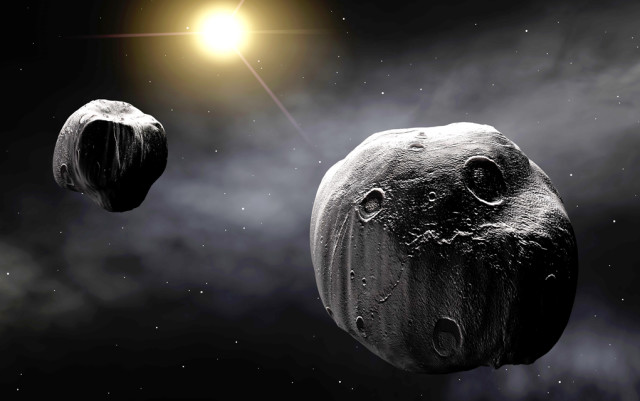
In December 2004, astronomers in Arizona discovered an asteroid the size of a cruise ship that appeared to be on a collision course with Earth. Initial observations of the space rock, known as Apophis, suggested that it had a very good chance of striking our planet in 2029. Later measurements ruled out this impact, but left open the possibility of a near miss in 2029 that would change the orbit slightly for a direct hit in 2036. Thankfully, NASA continued to track Apophis and has now eliminated the possibility of an impact anytime soon.
Predicting the path of an asteroid is a bit like forecasting the trajectory of a hurricane. At any moment in time we can measure the position, speed and direction of motion. There are always uncertainties in each of these measurements.
Projecting forward in time, the range of possible locations only expands, leading to the cone-like forecasts issued by the National Hurricane Center. There is value in providing advance warning to potentially affected areas, even as new observations gradually refine the predictions. Just as changing conditions in the atmosphere and ocean can alter the path of a hurricane, gravitational tugs from the planets can modify the orbit of an asteroid. So continued tracking of potential threats is highly recommended.
“My own take on this is that protecting the planet is a long-term commitment,” says Marc Buie, a staff scientist at Southwest Research Institute in downtown Boulder. Buie relocated to Colorado in 2008 after working for 17 years at Lowell Observatory in Flagstaff, Arizona. During his career, he’s helped discover thousands of objects in all parts of the solar system.
He is currently involved in an effort led by the B612 Foundation to launch a privately-funded space telescope called Sentinel, which is designed to track asteroids that may threaten the future of humanity.
“There are lots of ways that we can get smacked around by nature, and this one is actually preventable,” he says.
Unlike hurricanes, the season for killer asteroids never ends.
Earlier this month an object known as “2013 TX68” sailed past the planet at a distance 10 times further than the moon. As the name might suggest, it was just discovered a few years ago and could only be tracked for several days before disappearing into the darkness of space.
From these limited observations, astronomers knew it would return around the first week of March 2016, but the closest approach could have been anywhere from a few times Earth’s radius to 35 times the distance to the moon.
There was never a significant danger that it would collide with Earth, but an asteroid the size of a basketball court could certainly cause some damage. Just ask the people of Chelyabinsk.
In mid-February 2013, a space rock about half the size of 2013 TX68 entered the atmosphere above this industrial city in southern Russia.
Moving at 40,000 miles per hour, the object exploded in a spectacular air-burst more than 18 miles above the city, with only small pieces eventually reaching the ground.
The scene was captured by numerous dashboard cameras and surveillance videos, showing several bright flashes and a persistent contrail illuminated by the morning sun.
There was just enough time for startled residents to flock to their windows before the shock wave hit a few minutes later, a sonic boom that sent glass flying into thousands of buildings and injured more than 1,500 people.
“We’ve been proposing a new kind of survey instrument that will find more of these objects,” Buie says.
He’s been working with the B612 Foundation and locally with Ball Aerospace to design Sentinel, an infrared space observatory that will complement the capabilities of telescopes on Earth. The goal over the next decade is to catalog 90 percent of the dangerous asteroids, roughly down to the size of a football field. “Sentinel and B612 is all about warning time,” he says. “We want to give more than just duck and cover warning.”
What would we do if we found another asteroid like Apophis, but we couldn’t rule out an impact in the future? Although it might make a better Hollywood script, blowing up an incoming asteroid just creates several smaller problems on roughly the same trajectory.
With enough warning time, there’s no need for such a drastic response. By covering the dark surface of an asteroid with something highly reflective like talcum powder, the increased push from sunlight will slowly modify its orbit. Eventually, a probable impact turns into a near miss.
The population of potentially dangerous asteroids larger than a football field is currently estimated at 20,000 or more, but only a small fraction have already been discovered. Small investments to identify and track these objects over the coming decades will give humanity the advance warning we need to avoid an unexpected catastrophe.
Travis Metcalfe, Ph.D., is a researcher and science communicator based in Boulder, Colorado. His nonprofit organization accepts contributions to support future Lab Notes columns at labnotes.whitedwarf.org














